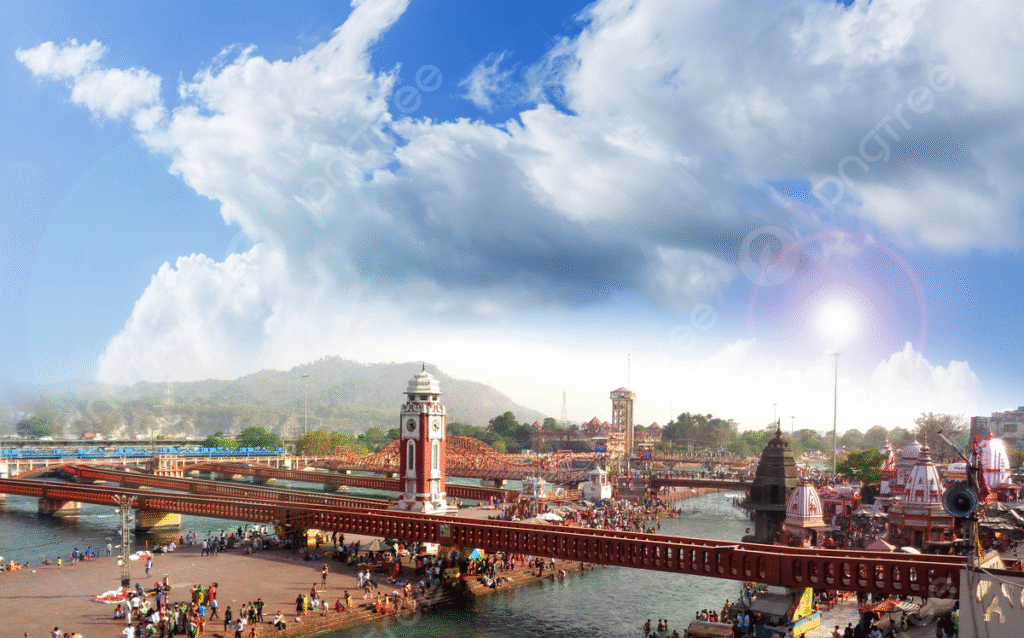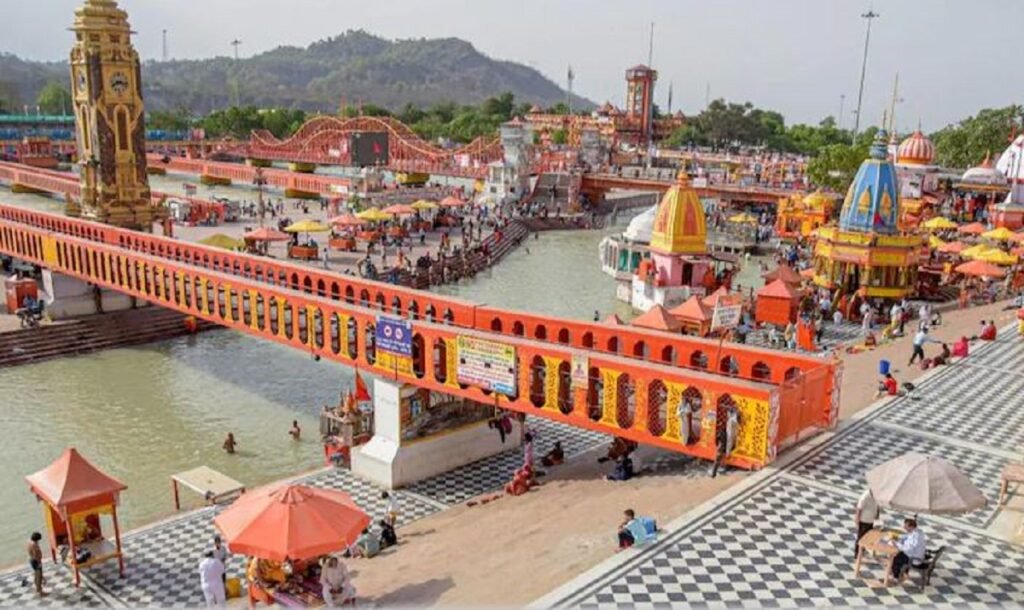Har Ki Pauri, set on the holy banks of the Ganga in Haridwar, Uttarakhand, is a revered pilgrimage site, pulsating with ancient legends, vibrant traditions, and the devotion of millions. A visit to this iconic ghat is considered a once-in-a-lifetime spiritual experience, drawing not only pilgrims but also culture seekers and global tourists.
Har Ki Pauri is a sacred ghat (“steps to the water”) located in the heart of Haridwar, Uttarakhand, by the Ganges River. The name literally means “steps of the Lord,” believed to be imprinted with Lord Vishnu’s footprints, making it a significant site for millions of devotees. Every sunrise and sunset here is painted with the spiritual fervor of hymns, bells, and the iconic Ganga Aarti, transforming the river’s edge into a celestial spectacle.
Key Details:
| Category | Details |
|---|---|
| Location | Haridwar, Uttarakhand, banks of River Ganga |
| Cultural Significance | Site for ritual bathing, Ganga Aarti, Kumbh/Ardh Kumbh Mela, footprint of Lord Vishnu |
| History | Built by King Vikramaditya in memory of brother Bhatrihari; Amrit fell here as per myth |
| Main Attraction | Daily Ganga Aarti, Brahmakund, sacred river bathing |
| Nearby Attractions | Mansa Devi Temple, Chandi Devi Temple, Bharat Mata Mandir |
| Opening Hours | Open all day (24 hours) |
| Aarti Timings | Morning: 5:30–6:00 am; Evening: 5:30–7:00 pm (seasonal variation) |
| Entry Fee | Free (VIP seating: ₹500–₹1000) |
| Best Time to Visit | October to March (pleasant weather, less crowded); also during major festivals |
| Route (from Delhi) | Train: 4.5 hrs, ₹200–₹3100; Bus: 5.5 hrs, ₹380–₹950; Flight:+Taxi: 2.5 hrs, ₹4100+ |
| Accommodation | Guesthouses, hotels: ₹1,012/night (budget), Packages start ₹13,611 |
| Cost of Travel (Typical) | Budget trip: ₹2,000–₹4,000; Mid: ₹6,000–₹12,000; Luxury: ₹18,000+ per person |
| Local Transportation | Autos/Rickshaws: ₹50–₹200; Per day: ₹443 (avg spend) |
History and Etymology
The legend of Har Ki Pauri stretches back to the Vedic era. It is widely believed that Lord Vishnu descended to this holy ghat, leaving his celestial footprints, which can still be seen engraved in stone. The literal translation is “the steps (pauri) of the Lord (Har)”, with “Har” commonly referring to Shiva or Vishnu, depending on the tradition.
A major redevelopment occurred during the rule of King Vikramaditya, who constructed the ghats in memory of his brother Bhatrihari, who meditated along the Ganges. Over centuries, it evolved from a sacred spot visited by sages to a centerpiece for mass congregations like the Kumbh Mela and the daily Ganga Aarti.
Spiritual Significance and Culture
Har Ki Pauri is more than just a riverside platform; it is the spiritual epicenter of Haridwar. Devotees believe that a dip here cleanses lifetimes of sins, paving the way for moksha (liberation). The air resonates with prayers, incense, and the luminous reflection of floating diyas.
Several rituals and festivals animate the ghat:
- Daily Ganga Aarti: Held every evening, priests clad in white perform synchronized rituals with lamps and chants, drawing throngs of devotees and tourists.
- Kumbh Mela: Every 12 years, millions gather for a dip during this grand fair.
- Ardh Kumbh and Vaisakhi: Celebrations every 6 years and annually, further solidify its role as a spiritual beacon.
- Ram Katha and Cultural Events: Recent news highlighted events like Ram Katha recitations, witnessing enormous cultural participation.
Tourist Attraction and Experience
For visitors, Har Ki Pauri offers:
- A unique confluence of faith and festivity, especially during the evening Aarti.
- A place of magnificent river views, humming activity, and spiritual solace.
- Access to nearby temples, local markets, traditional eateries, and dharamshalas (pilgrim lodges).
The ghat area is well-maintained with facilities for pilgrims, dedicated security, and lighting. Tourists can book accommodations ranging from simple guesthouses to riverside hotels.

Route, Access, and Connectivity
Har Ki Pauri is centrally located in Haridwar and is easily accessible:
- By Air: Nearest is Jolly Grant Airport (Dehradun) about 72 km away. Taxis and buses are available for direct travel.
- By Train: Haridwar Railway Station is well-connected to major Indian cities and just a short ride to the ghat.
- By Road: Accessible by national highways and state buses; private vehicles, rickshaws, and taxis ply frequently from the bus stand and city center.
Har Ki Pauri and the Local Economy
Tourism at Har Ki Pauri is a major contributor to Haridwar’s economy:
- The steady influx of millions supports hotels, guesthouses, local markets, transport, and small businesses.
- Major festivals like the Kumbh Mela infuse substantial revenue, benefitting not just Haridwar but the entire region of Uttarakhand.
- Local artisans, boatmen, and vendors rely on the footfall, especially during peak pilgrimage seasons and holidays.
Legends and Heritage
Har Ki Pauri’s legend is woven into India’s spiritual consciousness:
- Myth claims that a few drops of Amrit (elixir) from the celestial Kumbha, carried by Garuda, fell here, sanctifying the spot forever.
- The Brahmakund area, the focal point of the ghat, is believed to be the exact location where Amrit fell and is considered the most revered bathing spot.
- The footprints of Lord Vishnu, visible at the ghat, act as tangible testimony to these age-old stories.
Annual Festivals and Events
- Kumbh and Ardh Kumbh Mela: These events transform Har Ki Pauri into a vibrant fairground, attracting millions. Temporary settlements, camps, and elaborate security arrangements are made for the vast influx of visitors.
- Vaisakhi: This annual harvest festival is marked by prayers and ritual bathing, especially among North Indian Hindus.
- Ganga Dussehra: Marked by mass dips in the river, celebrating the cosmic descent of the Ganges.
- Special Aartis and Devotional Concerts: Frequently organized, drawing artists, poets, and spiritual leaders, such as recent programs by figures like Kumar Vishwas.
Practical Tips for Visitors
- Expect large crowds during peak festivals; plan accordingly to secure space for the Ganga Aarti.
- Modest, traditional attire is appreciated in this sacred space.
- Secure valuables and follow instructions from local authorities, especially during large events.
- Stay hydrated and be mindful of river currents during ritual bathing.
Modern Developments and News
Recent initiatives by the Uttarakhand government aim to further develop and preserve Har Ki Pauri:
- “Har Ki Pauri Corridor” proposals are underway, modeled after successful temple corridors in Kashi and Ujjain, aiming to streamline pilgrimage and improve facilities.
- Recent news highlights the social, legal, and cultural dialogues around such projects, including concerns over encroachment and heritage preservation.
- Innovative approaches such as online booking for Ganga Aarti and improved crowd management are improving the tourist and pilgrim experience.
FAQs About Har Ki Pauri
What is the best time to visit Har Ki Pauri?
The most spiritually vibrant time is during the evening Ganga Aarti or during large festivals like Kumbh Mela and Vaisakhi.
Are there hotels close to Har Ki Pauri?
Yes, options range from budget guesthouses to mid-range and premium hotels with river views, booked easily online or directly at the site.
How long does the Ganga Aarti last, and is it free?
The Aarti usually lasts 30-45 minutes each morning and evening. Attendance is free, but donations are welcomed.
Why is Har Ki Pauri considered so sacred?
It is believed to be where the Ganga leaves the Himalayas for the plains and where drops of divine nectar (Amrit) fell, as per Hindu mythology.
Is swimming or bathing allowed at Har Ki Pauri?
Yes, ritual bathing is encouraged but safety measures should be followed, especially for children and during festivals.
What transport options are available to reach Har Ki Pauri?
It is accessible by air (nearest: Jolly Grant Airport), train (Haridwar Jn.), and road, with local transport options available for intra-city travel.
Has Har Ki Pauri witnessed any recent developments?
Yes. The proposed corridor, improvements in crowd management, and digitization of certain services like online booking for Aarti have been making headlines recently.
Conclusion
Har Ki Pauri is not merely a pilgrimage spot but a living testament to India’s spiritual resilience, history, and community spirit. Whether experienced as a serene riverside sojourn, a bustling festival ground, or a timeless symbol of faith, Har Ki Pauri continues to flow, much like the sacred Ganga, uniting people across generations.
